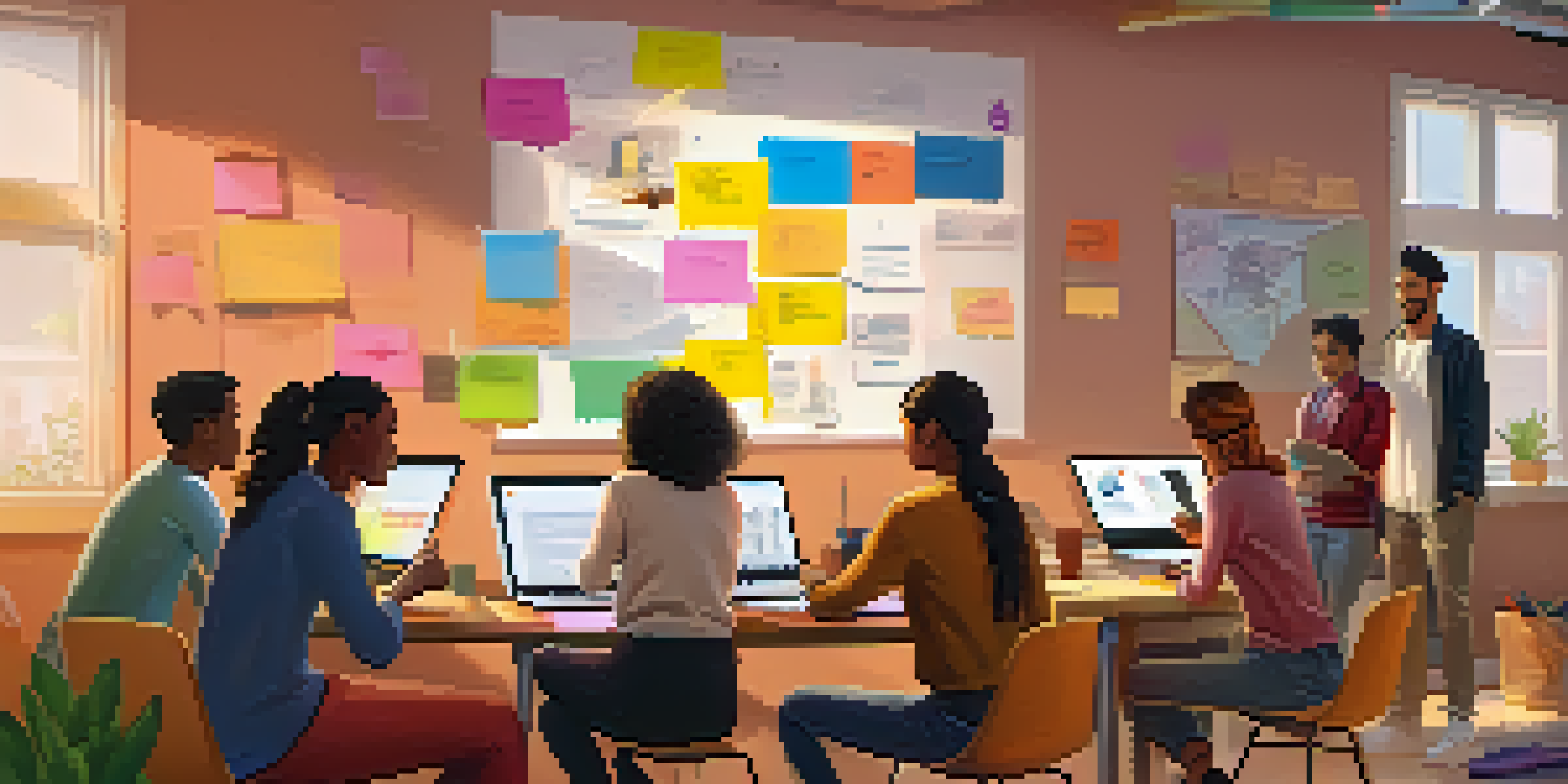The Role of Feedback in Online Learning Success

Understanding Feedback in Online Learning Environments
Feedback is a crucial component of online learning, serving as the bridge between students and educators. It helps learners understand their progress, pinpoint areas for improvement, and stay motivated. In an online setting, where face-to-face interaction is limited, feedback becomes even more vital for maintaining engagement and clarity.
Feedback is the breakfast of champions.
Just as a GPS provides directions to guide a traveler, feedback guides students on their educational journey. It can come in various forms, including grades, comments, or peer assessments. This multifaceted approach ensures that learners receive comprehensive insights into their performance.
Moreover, effective feedback fosters a sense of community among students. When learners share their experiences and insights, they can provide each other with valuable perspectives, enhancing the overall learning experience. This collaborative spirit is essential in online learning, where isolation can sometimes be a challenge.
The Importance of Timely Feedback for Student Growth
Timeliness in feedback is key to its effectiveness. When students receive feedback shortly after submitting work, they can make immediate adjustments and learn from their mistakes. This quick turnaround helps reinforce concepts while they are still fresh in the learner's mind.

Imagine trying to improve your golf swing: if you only get feedback after months of practice, it can be frustrating and less effective. Instead, receiving pointers after each swing allows you to make adjustments on the spot and see improvement much faster. This principle applies equally in an online learning context.
Feedback Guides Learning Progress
Feedback serves as a critical tool in online learning, helping students understand their progress and areas for improvement.
Furthermore, timely feedback encourages consistent engagement. Students are more likely to stay motivated and invested in their work when they see that their efforts are recognized and responded to promptly. It creates a dynamic learning environment where students feel supported and valued.
Constructive Feedback: The Pathway to Improvement
Constructive feedback focuses on growth and improvement rather than merely pointing out errors. It highlights strengths and offers specific suggestions on how to enhance performance, creating a balanced approach that fosters confidence. This type of feedback is essential for encouraging students to take risks and explore new ideas.
What is the shortest word in the English language that contains the letters: abc? Answer: feedback. That’s the breakfast of champions.
For example, instead of saying, 'Your essay is poorly written,' a constructive approach might be, 'Your main argument is strong, but consider clarifying your supporting points for better flow.' This not only identifies an area for improvement but also reinforces what the student did well, making it more likely they will engage positively with the feedback.
Moreover, constructive feedback cultivates a growth mindset, where students learn to view challenges as opportunities rather than obstacles. This mindset leads to a more resilient approach to learning, ultimately contributing to long-term success in online education.
Peer Feedback: Enhancing Collaboration and Learning
Peer feedback is a powerful tool in online learning, allowing students to learn from one another. When students review each other's work, they gain new perspectives and insights that can enrich their understanding of the subject matter. This collaborative approach also fosters a sense of community among learners.
Think of it like a potluck dinner: everyone brings a dish to the table, and the variety enhances the overall experience. In the same way, peer feedback encourages diverse viewpoints and ideas, which can lead to deeper discussions and learning opportunities. It helps students feel less isolated and more connected to their peers.
Timely Feedback Fuels Engagement
Receiving prompt feedback encourages students to stay motivated and make immediate adjustments to their work.
Additionally, providing feedback to others reinforces the giver's understanding of the material. By articulating their thoughts and critiques, students can clarify their own knowledge and enhance their critical thinking skills. This reciprocal process creates a win-win situation for everyone involved.
Incorporating Technology for Effective Feedback
Technology plays a significant role in facilitating feedback in online learning environments. Tools such as learning management systems (LMS) and online discussion forums enable instructors to provide timely and personalized feedback to students. These platforms streamline the feedback process, making it easier for both educators and learners.
For instance, video feedback can add a personal touch, allowing instructors to convey their thoughts more effectively than written comments alone. Seeing a teacher's enthusiasm and engagement can motivate students and make the feedback feel more genuine. This use of technology transforms traditional feedback methods into more dynamic interactions.
Furthermore, technology allows for continuous feedback loops. With features like quizzes and instant assessments, students can receive immediate feedback on their understanding of the material. This instant response not only helps learners adjust their study strategies but also reinforces their learning in real time.
Creating a Feedback Culture in Online Learning
Building a feedback culture in online learning starts with clear expectations. Educators should communicate the importance of feedback and encourage students to actively seek it out. When learners understand that feedback is a vital part of their journey, they are more likely to embrace it positively.
It's also essential to create an environment where feedback is viewed as a constructive tool rather than a criticism. By fostering an atmosphere of trust and respect, students are more likely to engage in open discussions about their work and be receptive to feedback from peers and instructors alike.
Constructive Peer Feedback Enhances Learning
Peer feedback fosters collaboration and provides diverse perspectives, enriching the overall learning experience.
Additionally, regular check-ins and feedback sessions can reinforce this culture. These moments allow educators to gauge student progress, address concerns, and celebrate achievements. When feedback becomes a routine part of the learning experience, it enhances both engagement and success.
Measuring the Impact of Feedback on Learning Outcomes
To understand the effectiveness of feedback, it's essential to measure its impact on learning outcomes. Educators can track student performance over time and analyze how feedback correlates with improvements in grades, understanding, and engagement. This data can provide valuable insights into what types of feedback are most effective.
For example, if students consistently perform better after receiving specific types of feedback, educators can refine their approaches and focus on what works best. It’s like a scientist conducting experiments: by analyzing results, they can make informed adjustments to hypotheses and methods.

Moreover, gathering student feedback on the feedback process itself can be beneficial. Students can share their experiences and preferences regarding how they receive feedback, enabling educators to tailor their approaches for maximum effectiveness. This iterative process ensures that feedback remains relevant and impactful for all learners.